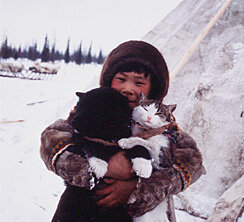Arctic Indigenous Peoples
Indigenous peoples have inhabited the Arctic for thousands of years. The proportion indigenous people is estimated to be about 10 percent of total population living in arctic areas. There are over 40 different ethnic groups living in the Arctic.
Arctic indigenous peoples include for example Saami in circumpolar areas of Finland, Sweden, Norway and Northwest Russia, Nenets, Khanty, Evenk and Chukchi in Russia, Aleut, Yupik and Inuit (Iñupiat) in Alaska, Inuit (Inuvialuit) in Canada and Inuit (Kalaallit) in Greenland. All of the above-mentioned countries except Iceland have indigenous peoples living within their Arctic territory. Official statistics do not necessarily recognize indigenous populations separately, although differences occur. The number of indigenous people is not accurate because of the definition of indigenousness.
There is a great variation of cultural, historical and economical backgrounds among the groups. However, a common feature for most of the indigenous communities in the Arctic is that they have already undergone substantial changes due to the globalization of the western way of life, state policies, modern transport and the introduction of mixed economy.
In general, indigenous people have a specific connection to land that they have inhabited. Other features, for example distinct language, culture and traditional livelihoods such as reindeer herding, fishing and hunting are characteristics of indigenous people in the Arctic. Industrialization, social change and environmental problems such as climate change, however, present threats to the continuity of these livelihoods and culture.
Recently, political organization of indigenous peoples has led to international recognition and clarification of human and political rights concerning indigenous populations. Rights to land and natural resources are an important part of the culture and survival of indigenous peoples in the Arctic.
Settlement in the Arctic regions
Arctic areas are inhabited approximately by four million people according to the AHDR definition (Arctic Human Development Report) of the Arctic. The settlement area is divided between eight Arctic countries; Canada, United States, Russia, Finland, Sweden, Norway, Iceland and Denmark. The circumpolar region is extremely sparsely populated. Using more broad definition, according to the University of the Arctic Atlas, there are approximately 13.1 million people living in the area of the circumpolar North.
During the 1950s and 1960s, the number of Arctic people started to grow rapidly because of improved health care for indigenous populations and the discovery of vast natural resources located in North which led to a large influx of immigrants. Recently population growth in the Arctic has slowed down in general and in some cases (e.g. Russian North) the total population has been even declining. It is estimated that two thirds of the total population lives in relatively large settlements. The settlement of the indigenous peoples living in circumpolar countries is characterized by small, widely scattered communities.
Climate change poses a new threat for all of the indigenous peoples
Regardless of underlying causes, the Arctic is undergoing a period of significant change that is likely to continue well into the next century, if not longer, and affect all sectors of the circumpolar North. People in the Arctic are worried about contaminants, land use, climate, security and access in the form of rights to land and sea. Arctic peoples often point out that their environment has always been dynamic and that constant adaptation to ‘change’ is simply a part of what they do and who they are (Forbes, B.C. Who are the peoples of the North? WWF Circle 2/2010: 6-9).
Climate change significantly impacts the traditional harvesting activities of indigenous peoples. Rapid weather changes and occurrence of thin ice and severe weather conditions (e.g. strong winds and storms) makes hunting more dangerous. Furthermore, disappearing sea ice affects many species that are subject to harvest, for instance polar bears, seals, whales and some fish stocks depend on ice cover. Additionally, the ice plays an important role in sea temperature regulation and primary productivity. As a result, the livelihoods connected with hunting, fishing and herding are under threat. Indigenous peoples have an especially strong bond with nature and the changes in harvesting activities may have implications on the economy, society, culture and health.
Eventually, the survival of many groups as distinctive peoples is endangered. Additionally, housing, infrastructure and transport connections of coastal indigenous communities are seriously affected by climate changes, with rising maintenance costs and sometimes even the necessity of relocation.



